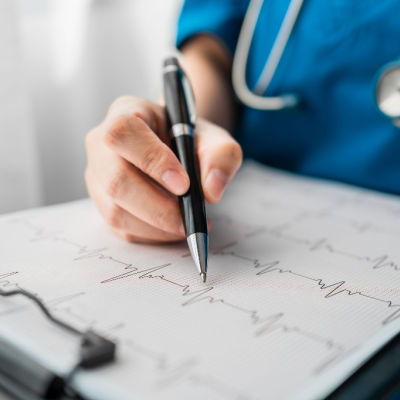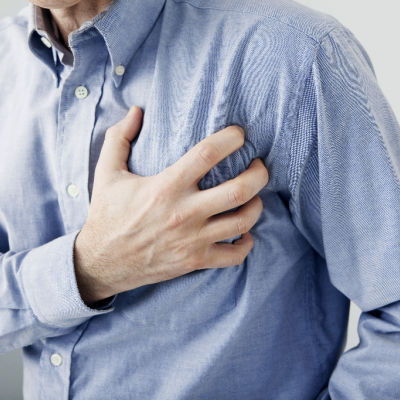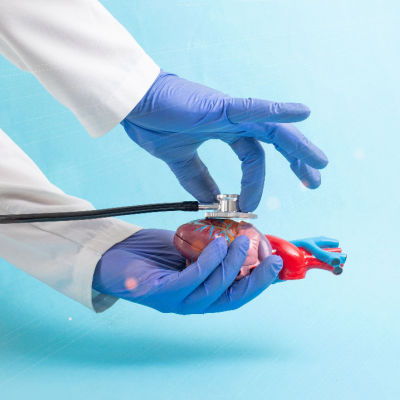What is it called when your heart stops while sleeping? This condition is known as sleep apnea. There are multiple types of sleep apnea, with the most common being obstructive sleep apnea or OSA. Becoming educated on the various types of sleep apnea can help you determine which type you have, the causes, the symptoms, and the best treatment options.
Connection Between Sleep Apnea & Heart Disease
Various studies have found that obesity can play a role in the development of heart disease and sleep apnea. But, having sleep apnea whether a person is obese or not, will still increase their chances of developing heart disease.
Sleep apnea has damaging effects on the cardiovascular system. This is due to the constant pauses in a person’s breathing that can put stress on the heart. For example, every time a person pauses while breathing, the level of oxygen in their blood also drops. This can activate the sympathetic nervous system.
Furthermore, when a person with OSA or obstructive sleep apnea tries to breathe, they begin to breathe in via closed or narrowed upper airways. This can put significant pressure on the chest cavity, which can then damage the heart. Constant changes in intrathoracic pressure can cause damage to the heart and result in atrial fibrillation, heart failure, and even issues with the way blood flows to the heart.
Finally, repetitive changes in a person’s oxygen levels can put a lot of stress on the body. This is known as oxidative stress and can eventually lead to heart disease because it can encourage systemic inflammation.
Types of Sleep Apnea
What are the warning signs of sleep apnea? If you snore loud enough that it causes a disturbance to the person sleeping next to you, or you wake up gasping for air, you could have sleep apnea. Another warning sign is pausing in your breathing while you are sleeping. Let us read about some of the various types of sleep apnea.
OSA- Obstructive Sleep Apnea
OSA is the most familiar type of sleep apnea and happens when there is a blockage within the throat and mouth. For instance, the tongue may rest against the soft palate while a person is sleeping. The soft palate and uvula can rest against a person’s throat, making it harder to breathe.
Central Sleep Apnea
Central sleep apnea also makes it difficult for a person to breathe, but it isn’t caused by a blockage within the upper airways. The cause of central sleep apnea is neurological. People with central sleep apnea do not snore. Instead, you may notice symptoms such as insomnia, trouble concentrating, and waking up feeling panicky or with shortness of breath.
Complex Sleep Apnea Syndrome
A person can have more than one type of sleep apnea. Complex sleep apnea syndrome is a combination of central and OSA sleep apnea. Sometimes, complex sleep apnea is evident following a sleep study. But, it is also possible that sleep apnea may not improve even after the use of a CPAP machine.
Cardiomyopathy is a broad term that refers to a disease of the heart muscle. The heart muscle becomes enlarged, thick, or abnormally rigid, and as cardiomyopathy progresses, the heart becomes weaker. Cardiomyopathy can lead to heart rhythm problems, heart failure, and sudden cardiac arrest.
Symptoms of cardiomyopathy generally get worse as the disease progresses. In some cases, patients may not experience any symptoms in the early stages.
Common symptoms include:
- Shortness of breath
- Swelling in the ankles, feet and legs
- Fatigue
- Irregular heartbeat
- Dizziness or lightheadedness
Concerned that you might have cardiomyopathy? Contact us immediately. Treatment can help halt the progression of the disease.
Heart disease is the number one killer of both men and women worldwide. According to the American Heart Association, about 2,150 Americans die each day from heart disease or stroke. This equates to one person dying every 40 seconds. Your cardiologist can determine your risk of developing heart disease or a heart attack through EKGs and stress tests.
What Kind of Tests are Performed to Check for Heart Disease?
An EKG, also known as an electrocardiogram, measures your heart’s activity. EKGs can be administered while you are lying on a table to take a ‘snapshot’ of your current heart rate, or may be administered as part of a stress test.
Your cardiologist may recommend a stress test if you have heart disease or are at an increased risk of developing heart disease. Stress tests allow cardiologists to pinpoint whether you are experiencing symptoms of heart disease, such as chest pain, shortness of breath, or an irregular heartbeat. They are often conducted while you exercise, but can also be performed a number of other ways, including by administering medicine to make your heart react as if you were exercising.
In some cases, a nuclear stress test is recommended. This is a great diagnostic tool for checking blood flow to the heart. During this test, a small amount of radioactive tracer is administered into the vein through an IV. Then, a camera is used to detect the tracer and produce images of the heart. This test is allows us to determine whether you are getting adequate blood flow to the heart while active.

How Do These Tests Work?
Before the test begins, we will place electrodes on your chest, arms and legs. These electrodes are connected to a machine that will monitor and record your heart activity.
During typical exercise stress tests, you may either use a treadmill or a stationary bike. The EKG will monitor you from baseline, while you are active, and after you finish exercising. The test has different phases, each of which lasts about three minutes. After each phase is complete, the speed or resistance will be increased.
Both your heart rate and blood pressure will be monitored throughout the exercise. The test ends either once you reach your maximum heart rate, when there are symptoms of stress on the heart or lungs, or when we find that there is decreased blood flow to the heart muscles. We will also stop the test if you experience an irregular heartbeat or if your blood pressure drops. The entire test will take anywhere from 15 to 30 minutes.
Your cardiologist will look at the patterns of electrical activity in the heart and contact you within a few days with the results. In some cases, we may even be able to tell you the results immediately following the test.
If you are at risk of heart disease or are experiencing fatigue, shortness of breath, or chest pain, call us today.
Heart rhythm conditions are often a sign of an underlying issue, and may even pose problems in themselves. So what are some of the most common heart rhythm conditions?
Atrial Fibrillation
Atrial fibrillation (AF) occurs when the atria, or upper chambers of the heart, begin to beat out of sync with the ventricles, or lower chambers of the heart. Characterized by a rapid rhythm, AF reduces the heart’s effectiveness at pumping blood. As a result, blood clots can form in the heart chambers, potentially reaching the brain and causing a stroke or heart failure.
AF is typically due to an existing heart condition. Other causes include high blood pressure, heart attack and coronary artery disease. Dizziness, feeling out of breath, tiredness, a feeling that the heart is racing or fluttering, uneven heartbeat, and chest pain are all common symptoms.
Atrial fibrillation is common in older adults and may not present obvious symptoms. Seeing a doctor at the first onset of AF symptoms is important to avoid serious complications. The typical goals of treatment are restoring rhythm to as close to normal as possible and preventing the formation of blood clots.
Arrhythmia
Arrhythmia is a problem with the rhythm of the heartbeat-beating too fast, too slow, or with an irregular rhythm. Many arrhythmias are harmless, but some can be life-threatening, especially since a lack of blood flow to the body can damage the brain, heart and other organs.
Noticeable symptoms of arrhythmia include fainting, dizziness, heart palpitations, weakness, fatigue, shortness of breath and chest pain. Arrhythmia can be caused by heart disease, stress, smoking, heavy alcohol use and certain medications.
Treatment for arrhythmias depends on the type and severity of irregular heart rhythm. In most cases, people with arrhythmias can live normal, healthy lives, but never take the risk of a ‘wait-and-see’ approach.
Remember, anything other than your usual, steady heartbeat could be a sign of a dangerous heart condition. Always discuss irregular heartbeat symptoms with your cardiologist.






